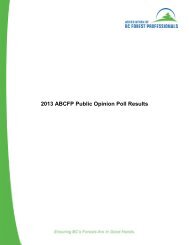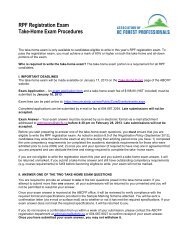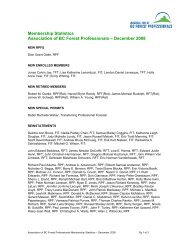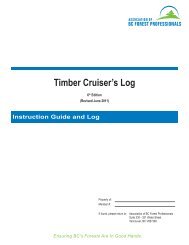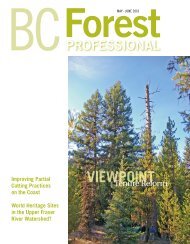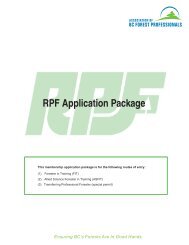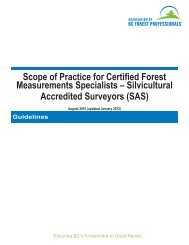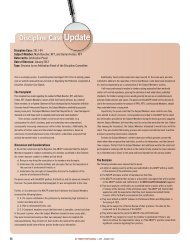Accredited Timber Cruisers - Association of BC Forest Professionals
Accredited Timber Cruisers - Association of BC Forest Professionals
Accredited Timber Cruisers - Association of BC Forest Professionals
Create successful ePaper yourself
Turn your PDF publications into a flip-book with our unique Google optimized e-Paper software.
Interim Scope <strong>of</strong> Practice for Certified <strong>Forest</strong> Measurements<br />
Specialists – <strong>Accredited</strong> <strong>Timber</strong> <strong>Cruisers</strong> (ATC) and <strong>Accredited</strong><br />
<strong>Timber</strong> Evaluators (ATE)<br />
GUIDELINES<br />
June 2009
Contents<br />
Background 3<br />
The ATE and ATC 4<br />
The Role <strong>of</strong> an <strong>Accredited</strong> <strong>Timber</strong> Cruiser (ATC) 4<br />
Scope <strong>of</strong> Practice <strong>of</strong> an <strong>Accredited</strong> <strong>Timber</strong> Cruiser (ATC) 5<br />
Example 1 5<br />
Example 2 6<br />
The Role <strong>of</strong> an <strong>Accredited</strong> <strong>Timber</strong> Evaluator (ATE) 6<br />
Scope <strong>of</strong> Practice <strong>of</strong> an <strong>Accredited</strong> <strong>Timber</strong> Evaluator (ATE) 6<br />
Example 1 7<br />
Example 2 8<br />
Interim Scope <strong>of</strong> Practice for Certified <strong>Forest</strong> Measurements Specialists – ATC and ATE 2
Background<br />
These interim guidelines on scope <strong>of</strong> practice for ATCs and ATEs have been<br />
developed by the <strong>Forest</strong> Measurements Board (FMB) and approved by the A<strong>BC</strong>FP<br />
council. They are meant to enable the transfer <strong>of</strong> ATCs and ATEs from the Applied<br />
Science Technologists and Technicians <strong>of</strong> <strong>BC</strong> (ASTT<strong>BC</strong>) to the A<strong>BC</strong>FP. After the<br />
transfer has been completed, these guidelines will be revised so they are in the same<br />
format as the Scope <strong>of</strong> Practice Guidelines for Registered <strong>Forest</strong> Technologists and<br />
will include more specific examples <strong>of</strong> practices for ATCs and ATEs.<br />
The FMB was originally called the <strong>Timber</strong> Cruising Accreditation Board and<br />
the Certification Program was established in 1994 with the first Accreditation<br />
(Certification) <strong>of</strong> <strong>Cruisers</strong> on September 15th, 1995. ASTT<strong>BC</strong> developed the <strong>Timber</strong><br />
Cruising Certification Program as a way to ensure that the practitioners carrying<br />
out timber cruising activities were competent and, within a pr<strong>of</strong>essional registration<br />
scheme, to be pr<strong>of</strong>essionally accountable for their work. The program, launched<br />
with the cooperation <strong>of</strong> practitioners and the then Ministry <strong>of</strong> <strong>Forest</strong>s, was managed<br />
by the <strong>Timber</strong> Cruising Accreditation Board, subsequently re-named the <strong>Timber</strong><br />
Cruising Certification Board and then the <strong>Forest</strong> Measurements Registration Board<br />
(FMRB).<br />
The FMRB’s certification program provided for the registration <strong>of</strong> cruisers as either<br />
ATCs or ATEs. In December 2008, ASTT<strong>BC</strong> and the A<strong>BC</strong>FP reached an agreement to<br />
transfer the <strong>Timber</strong> Cruising Certification Program from the ASTT<strong>BC</strong> to the A<strong>BC</strong>FP.<br />
During this transfer, the FMRB was re-named as the <strong>Forest</strong> Measurements Board<br />
(FMB) and as a condition <strong>of</strong> the transfer, a scope <strong>of</strong> practice for ATCs and ATEs had<br />
to receive joint approval and ultimately, approval from the A<strong>BC</strong>FP council.<br />
Interim Scope <strong>of</strong> Practice for Certified <strong>Forest</strong> Measurements Specialists – ATC and ATE
The ATE and ATC<br />
The ATE is an <strong>Accredited</strong> <strong>Timber</strong> Evaluator, a senior or supervisory individual who<br />
is responsible for planning, organizing, training, quality assurance and reporting <strong>of</strong><br />
timber cruising results.<br />
The ATC is an <strong>Accredited</strong> <strong>Timber</strong> Cruiser, who with a minimum <strong>of</strong> two years field<br />
experience and competencies, and who is responsible for recording, supervising and<br />
instructing subordinates with a minimum <strong>of</strong> supervision.<br />
In all cases, ATCs and ATEs will only carry out work for which they are authorized<br />
under these interim guidelines and qualified based on their education, training,<br />
experience and proven competencies and are expected to comply with the<br />
appropriate A<strong>BC</strong>FP Bylaws.<br />
These guidelines are intended to reflect the successful working relationship that<br />
currently exists between ATCs and ATEs and other forest pr<strong>of</strong>essionals.<br />
The Role <strong>of</strong> an <strong>Accredited</strong> <strong>Timber</strong> Cruiser (ATC)<br />
ATCs typically work within a forestry team that includes measurement pr<strong>of</strong>essionals<br />
and administrative staff. In addition to certain education related distinctions<br />
between ATCs and other forest pr<strong>of</strong>essionals, the role <strong>of</strong> ATCs also varies depending<br />
upon the size and complexity <strong>of</strong> the project, as well as the experience, competency<br />
and proven expertise <strong>of</strong> the individual ATC.<br />
ATC’s functions and pr<strong>of</strong>essional accountabilities within their scope <strong>of</strong> practice tend<br />
to be more narrowly defined and focused (primarily field aspects <strong>of</strong> timber cruising),<br />
than those <strong>of</strong> ATEs, RPFs or RFTs. There is an emphasis on shorter time frames,<br />
practical skills and operating within established technical parameters and protocols.<br />
Recognition <strong>of</strong> the consequence <strong>of</strong> actions and decisions and their impact helps<br />
define the scope <strong>of</strong> practice limits for the ATC. For example, collecting many types <strong>of</strong><br />
cruise related measurement data and attesting to its completeness, correctness and<br />
clarity would be considered within the practice scope <strong>of</strong> an ATC.<br />
While ATCs are expected to sign and seal/stamp appropriate pr<strong>of</strong>essional work<br />
products as per Bylaw 10.5, their normal work product (field timber cruising<br />
measurements) is not conducive to sealing/stamping. Therefore, their field plot<br />
product must display their name and pr<strong>of</strong>essional designation.<br />
Interim Scope <strong>of</strong> Practice for Certified <strong>Forest</strong> Measurements Specialists – ATC and ATE
Scope <strong>of</strong> Practice <strong>of</strong> an <strong>Accredited</strong> <strong>Timber</strong> Cruiser (ATC)<br />
The following practice scope descriptions and examples are not intended to be a<br />
comprehensive listing nor a complete definition <strong>of</strong> the scope <strong>of</strong> practice for ATCs.<br />
Rather, they are meant to provide a generally accepted understanding <strong>of</strong> existing<br />
roles and responsibilities that may be used as guides in other areas <strong>of</strong> forest<br />
measurements practice. More scope <strong>of</strong> practice examples will be developed as<br />
appropriate.<br />
Technical aspects <strong>of</strong> an ATC’s scope <strong>of</strong> practice include:<br />
• <strong>Forest</strong> measurements for the purpose <strong>of</strong> timber cruising,<br />
• Portions <strong>of</strong> forest resource surveys and inventories which require the<br />
supervision and implementation <strong>of</strong> forest measurements required for timber<br />
cruising, and<br />
• Photogrammetric interpretation and mapping required for timber cruising<br />
and evaluation under the direction <strong>of</strong> an ATE, RFT or RPF.<br />
The aspects <strong>of</strong> timber cruising-related measurement practices that may be conducted<br />
by an ATC include:<br />
• Preparing for cruise surveys and implementing and performing data<br />
collection for timber cruises,<br />
• Preparing and implementing operational timber reconnaissance and forest<br />
timber inventory data collection,<br />
• Collecting timber appraisal, and or timber evaluation data,<br />
• Interpreting forest features and attributes from air photos with respect to<br />
timber reconnaissance and timber cruising and evaluation under the direction<br />
<strong>of</strong> an ATE, RFT or RPF.<br />
• Verifying the above interpreted forest features through ‘on site’ procedures,<br />
and<br />
• Preparing operational timber cruising and evaluation maps and assisting<br />
with associated reports under the direction <strong>of</strong> an ATE, RFT or RPF.<br />
Example 1<br />
A logging plan map is received. The ATC ensures that all necessary data and<br />
information are provided and assists under the direction <strong>of</strong> an ATE, RFT or RPF to<br />
Interim Scope <strong>of</strong> Practice for Certified <strong>Forest</strong> Measurements Specialists – ATC and ATE
develop a cruise plan to a specified standard. The ATC will collect the data. The ATC<br />
may produce final maps and strata and may compile, or arrange to compile, the data<br />
and summarize in a report to a specified standard under the direction <strong>of</strong> an ATE,<br />
RFT or RPF.<br />
Example 2<br />
<strong>Forest</strong> inventory objectives are set. A forest pr<strong>of</strong>essional develops a sampling plan.<br />
An ATC, with appropriate competence and direction from an ATE, RFT or RPF, may<br />
follow photo interpretation procedures and/or classification systems to develop the<br />
initial estimation <strong>of</strong> the forest cover polygon attributes. An ATC, as noted above, can<br />
carry out field sampling activities to verify the estimated polygon attributes. The<br />
ATC may compile the data and summarize in a report to a specified standard under<br />
the direction <strong>of</strong> an ATE, RFT or RPF.<br />
The Role <strong>of</strong> an <strong>Accredited</strong> <strong>Timber</strong> Evaluator (ATE)<br />
ATEs typically work within a forestry team that includes forest pr<strong>of</strong>essionals and<br />
administrative staff. In addition to certain education related distinctions between<br />
ATEs and other forest pr<strong>of</strong>essionals, the role <strong>of</strong> ATEs recognizes the additional<br />
experience, knowledge and competencies that a supervisory position requires.<br />
ATE’s functions and pr<strong>of</strong>essional accountabilities within their scope <strong>of</strong> practice tends<br />
to be more narrowly defined and focused (timber cruising and evaluation) than<br />
those <strong>of</strong> RPFs or RFTs. There is an emphasis on shorter time frames, practical skills<br />
and operating within established technical parameters and protocols. Recognition<br />
<strong>of</strong> the consequence <strong>of</strong> actions and decisions and their impact helps define the scope<br />
<strong>of</strong> practice limits for the ATE. For example, designing, supervising and quality<br />
assurance <strong>of</strong> cruise related measurement data and attesting to its completeness,<br />
correctness and clarity would be considered within the practice scope <strong>of</strong> an ATE.<br />
ATEs are expected to sign and seal/stamp appropriate pr<strong>of</strong>essional work products as<br />
per Bylaw 10.5.<br />
Scope <strong>of</strong> Practice <strong>of</strong> an <strong>Accredited</strong> <strong>Timber</strong> Evaluator (ATE)<br />
The following practice scope descriptions and examples are not intended to be a<br />
comprehensive listing nor a complete definition <strong>of</strong> the scope <strong>of</strong> practice for ATEs.<br />
Rather, they are meant to provide a generally accepted understanding <strong>of</strong> existing<br />
roles and responsibilities that may be used as guides in other areas <strong>of</strong> forest<br />
measurements practice. More scope <strong>of</strong> practice examples will be developed as<br />
appropriate.<br />
Technical aspects <strong>of</strong> an ATE’s scope <strong>of</strong> practice include:<br />
Interim Scope <strong>of</strong> Practice for Certified <strong>Forest</strong> Measurements Specialists – ATC and ATE
• <strong>Forest</strong> measurements for timber cruising and standing timber evaluation<br />
• Portions <strong>of</strong> forest resource surveys and inventories which require the<br />
planning, supervision, implementation and quality assurance <strong>of</strong> forest<br />
measurements required for timber cruising,<br />
• Training, supervision and quality assurance for field measurements related to<br />
timber cruising and evaluation,<br />
• <strong>Timber</strong> valuation, and<br />
• Photogrammetric interpretation and mapping required for timber cruising<br />
and evaluation.<br />
The aspects <strong>of</strong> timber cruising-related measurement practices that may be conducted<br />
by an ATE include:<br />
• Preparing cruise surveys and sample designs to a specified standard and<br />
implementing, training and performing data collection, quality control and<br />
assurance for timber cruises,<br />
• Preparing, training, implementing and supervising operational timber<br />
reconnaissance and forest timber inventory data collection, as well as the<br />
quality assurance,<br />
• Collecting, preparing and summarizing timber appraisal, and or timber<br />
evaluation data<br />
• Interpreting forest features and attributes from air photos with respect to<br />
timber reconnaissance and timber cruising and evaluation,<br />
• Verifying the above interpreted forest features through ‘on site’ procedures,<br />
and<br />
• Preparing operational timber cruising and evaluation maps and associated<br />
reports.<br />
Example 1<br />
A logging plan map is received. The ATE will ensure that all necessary data and<br />
information is provided and develop a cruise plan to a specified standard. The ATE<br />
will collect, train, or supervise the collection and quality control <strong>of</strong> the data. The ATE<br />
should produce and review final maps and strata. The ATE may compile, or arrange<br />
to compile, the data and summarize in a report to a specified standard. The ATE may<br />
Interim Scope <strong>of</strong> Practice for Certified <strong>Forest</strong> Measurements Specialists – ATC and ATE
provide timber valuations.<br />
Example 2<br />
<strong>Forest</strong> inventory objectives are set. A forest pr<strong>of</strong>essional develops a sampling plan.<br />
An ATE, with appropriate competence, may follow photo interpretation procedures<br />
and/or classification systems to develop the initial estimation <strong>of</strong> the forest cover<br />
polygon attributes. An ATE, as noted above, will carry out, supervise and provide<br />
quality assurance for the field sampling activities to verify the estimated polygon<br />
attributes. The ATE may compile the data and summarize in a report to a specified<br />
standard.<br />
Interim Scope <strong>of</strong> Practice for Certified <strong>Forest</strong> Measurements Specialists – ATC and ATE
330-321 Water Street<br />
Vancouver, <strong>BC</strong> V6B 1B8<br />
Tel: 604.687.8027 Fax: 604.687.3264<br />
E-mail: info@abcfp.ca<br />
Website: www.abcfp.ca



